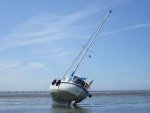Bru
Well-known member
That i don't doubt is true of humans in so called "quicksand"
But we're not talking about humans or about quicksand. There are numerous accounts of vessels being completely swallowed within a few tides after running aground on the Goodwins and the various sandbanks of the Thames Estuary
But we're not talking about humans or about quicksand. There are numerous accounts of vessels being completely swallowed within a few tides after running aground on the Goodwins and the various sandbanks of the Thames Estuary





